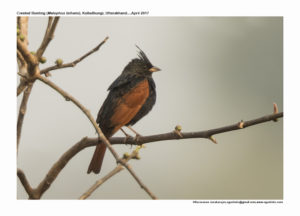
Crested Bunting Melophus lathami
Etymology:
- Melophus : Greek word melas – black; lophos -crest.
- Lathami : named after English Ornithologist Dr John Latham (1740–1837)
Vernacular Names: Hindi: Patthar-chiria, Pun: Bodal boli, Guj: Mor chakli, Kathai-pankh, Mor gandam, Mar: Turewala Bharit, Yuvraj.
Distribution in India: Summer and winter visitor in Himalayan foothills. Resident of Central India and North east India
Description: Size of 16–17 cm; wt. of 20–26 g. Distinctive, elongate bunting with prominent crest and plain, almost round-tipped tail; rufous wings in all plumages. The male breeding has elongated forecrown feathers that can be erected into prominent crest. The entire head and body are shiny black or brownish-black, with some rusty-rufous on thigh, uppertail- and undertail-coverts. The wing and tail are bright rusty-rufous, flight-feathers usually with dusky tips; iris is dark brown; bill is sometimes almost wholly pink in breeding season, but often with grey culmen or upper mandible, or wholly black. The legs are light pinkish-brown to dark purplish-brown. The male non-breeding has buffish-grey fringes on black body feathers. Second-winter male is much as adult, but with black tips on primary coverts. The female has distinctly shorter crest than male, overall body coloration dull buffy-olive, diffusely streaked darker, streaking boldest on breast, mantle and scapulars, finest and most intense on head; pale buffy eyering; rufous in wing and tail that tends to become faded with wear. The female non-breeding is sandy brown, with streaking bolder and more defined, belly weakly washed with pale yellow, which becomes cinnamon-buff on undertail-coverts. First-winter female resembles adult, but duller, with only weak rufous colour in wing, and more coarsely streaked overall. The juvenile of both sexes resembles adult female, but crest very short and inconspicuous, breast more boldly streaked, and overall colour tones buffer.
Habitat: It is found in open dry grassy or rocky hillsides and terraced cultivation with scattered bushes and rock outcrops. It is found from foothills to 2440 m in summer. In winter it descends lower in cultivated areas and amid dry scrub-jungle down to edge of plains.
Food Habits: They eat small grass seeds of various kinds, including fallen grains and some weed seeds. Sometimes small insects are eaten through fly catching on wings. They are usually seen in large flocks forging on the ground for seeds and grains. They eat insects during the breeding season
Breeding Habits: They breed in Apr to Jun in E China, Jul–Aug in Pakistan and NW India and Jun–Jul in W India and Apr in C Nepal. They are monogamous and solitary nester. The nest is built by female, male bringing some materials. The nest is a cup of fine rootlets, animal hair, mosses and dried grasses, placed in hollow on ground, under rock or in crevice near foot of bank or stone wall, typically concealed by clump of ferns or grasses. The clutch consists of 3 to 5 eggs. The incubation is done by female, male helps in feeding young. The nest is occasionally parasitized by Common Cuckoo.